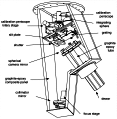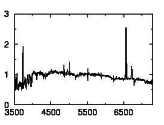
|

FAST Spectrograph
|

|

|

FAST Spectrograph
|

|
The following protocols have been established for taking data using the FAST spectrograph. Their purpose is to make automatic reduction possible while producing high quality spectra.
The standard set-up is:
300 gpm gratingUnless otherwise indicated, this setup is assumed for the exposure times we mention below.
3" slit
binby4 (binby2 may also be used)
- Take 5 binby4 and 5 binby2 DARK exposures at the beginning and end of each night. If you run out of time at the beginning of a night, remember to do it at the end of that night. DARKs are critical to obtain the highest quality of reductions. It is strongly preferred that you use a script: 'source /home/observer/scripts/dodarkall' from the rtshell. The script will run for about 2.5 hours. If you are unable to observe or you think you really need more darks, 'source /home/observer/scripts/dodark5' will take twice as long and twice the number of DARKs. Although the scripts are strongly preferred, you may also collect DARK exposures manually; see the FAST primer for details on the godark command.
- Take BIAS and FLAT exposures at the beginning and end of the night with the standard BIAS and FLAT script 'doflats.' Invoke it with 'source /home/observer/scripts/doflats', which will run for about 20 minutes. It will take 10 binby4 BIAS, 10 binby4 12-sec FLAT, 10 binby2 BIAS and 21 binby2 25-sec FLAT exposures. The script is strongly preferred, but you may do all this manually; however, you'll need to turn on the bright incandescent lamp manually and also remember to turn it off when done (all of this is automatic with the script). See the FAST primer for details on the bias or goflat commands.
- To summarize, the required numbers of calibrations for the standard setup are:
FLATS BIASES DARKS binby4 10 10 5 binby2 21 10 5
- FLATs are essential to calibrate the illumination of the CCD. If you change the grating/tilt during the night, take 10 FLAT exposures after you change the grating/tilt but before you observe any objects. If you will finish the night with the new grating/tilt, you may leave the flats until the end. The point is never to forget to take appropriate flats.
- Take 5 sky exposures in the standard setup at the beginning or end of the night. You should only try skies once you have developed observing expertise. Make sure that the guide camera gain is turned down all the way! For consistency, always name the sky observations "sky" and no other name. When taking sky exposures, it is a good idea to look at the 2-d image to check that there is no stellar spectrum in the exposure. Exposure times for sky exposures should be short, on the order of 2 to 10 seconds. Please remember to take a comparison after you have finished your sky exposures. These exposures are wavelength-calibrated and extracted to 1-d spectra, which requires a comparison. Sky exposures are Program '#57 Velocity Standards' and the P.I. is 'All'.
- Check your personal email and the 'observer' email for instructions on what to observe. Perry Berlind or Mike Calkins should either email or call you with recommended observations. Also, check the link "What to observe tonight" or Perry's notes for more help.
Check the observing binders on the shelf above the computer monitors in the control room for program-specific instructions.
- Comparisons should be taken after each new object RA and Dec. For binby2, a 10-sec exposure is needed (type 'cexx'), and for binby4 an 5-sec exposure is needed (type 'cex').
- The telescope should NOT be moved to another object during a comparison exposure even in cases where good wavelength solutions aren't especially important. Our automatic reduction system uses an algorithm that matches the telescope RA and DEC of objects and comparisons.
- If an object is underexposed, observe it on your second attempt for a sufficient time to get a scientific result; don't expect to add two or more poor spectra to get a reliable velocity. Underexposed spectra add greatly to the difficulty of extraction and require individual, time-consuming attention.
Doug Mink wrote qfast, an Iraf script that allows you to quickly (and roughly) reduce your spectra for a look at the telescope. It produces a plot of the 1-d wavelength-calibrated spectrum, calculates a velocity and marks the absorption and emission lines for that velocity. Note that there are wavelength-calibration files for the 300 gpm/600 tilt (comp300+600.ms) and 600 gpm/440 tilt (comp600+440.ms) gratings. Thus, you should be able to determine whether you have a sufficiently high SNR for a reliable velocity measurement. Although the R value can be used as a rough guide (the higher, the better), you should be able to see for yourself that, e.g., the Mg and Na lines are believable and that emission lines, if present, are clearly real and not noise spikes or cosmic rays.
- Standards
The catalog files containing the standards are in the /pool/Realtime/lib/catalogs directory on flwo60: massey.mct (rvstd.mct) for photometric (velocity) standards.
- Once a month, observe a throughput monitoring object, a white dwarf, such as HZ44, from the list of photometric standards using a 5" slit to gather as much light as possible in the slit.
- Nightly observe a photometric standard, one blue and one red. If possible and if the standard is not being observed in conjunction with AGN, SN, or QSO monitoring, it should be observed at an airmass no greater than 1.1.
- Observe a velocity template or velocity standard once a night. Usually you can do it while still in twilight.
- Please note carefully in the fastlog.lis file any slit or grating change and any comments for the observed object that may help identify its spectrum (position on the slit, clouds, etc.). Also please note any additional stars or galaxies that appear on the slit and could be mistaken for the target object. However, if the slit has been rotated, please indicate where the desired target is located in pixel row. WARNING: Avoid editing the fastlog.lis file while an exposure is in progress; if the exposure finishes before you, you will likely damage fastlog.lis. The format of fastlog.lis is fastidious, especially regarding quotation marks; it is easy to damage the file, so be careful!
- Please study the FAST OBSERVING PRIMER for further details on observing and telescope operating.